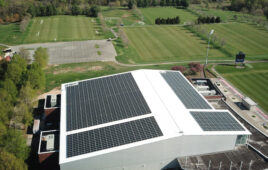Paradise Energy Solutions finished installation of a 1.792-MW, 4,480-panel solar array at home exterior manufacturer ProVia’s Cherry Ridge facility in Ohio. The system is among the largest privately-owned installations in the state and is expected to reduce electrical consumption by 60% at the facility.

Paradise Energy Solutions installed a 1.792-MW solar array atop ProVia’s Cherry Ridge manufacturing plant.
“As we investigated this project, we determined that we could successfully balance a socially responsible choice with economic feasibility, which made solar an excellent solution,” says Larry Troyer, CFO for ProVia. “This is a long-term investment that’s good for our company and good for the environment.”
The solar panels are installed on the rooftop and provide enough energy to run about 240 average-sized residential homes. ProVia also has solar installations at its Baltic, Sugarcreek and Walnut Creek facilities, however, Cherry Ridge is larger, and will generate 6.5 times the production of the other three combined
“We’ve always had great respect for ProVia, so it was an honor to partner with them on this project,” said Sheldon Stutzman, Solar Consultant with Paradise Energy Solutions. “ProVia continues to lead the way in manufacturing with highly-skilled people who bring innovative solutions to market. It’s very satisfying to be a part of that story.”
News item from Paradise Energy Solutions




From what I can see of the roof in this picture, there’s still quite a bit of installation space left on the main manufacturing area roof. Then there seems to be still more space on the loading docks. It’s always interesting to see specifics like, this array could power 240 homes. This puts one right at a 7.5K to 8k solar PV array to take care of average energy needs each day. Depending on soft costs in the area one could have 8kWp solar PV array on one’s roof for about, $2.25/watt installed for a grid tied system. IF one is in a housing tract and several of the folks in the tract want to Co-Op for bulk solar PV buying power, you might get it cheaper installed than $2.25/watt. With the ITC still valid until 2024, that 26% could also afford one a small smart ESS that could also add resiliency to one’s home during power outages.